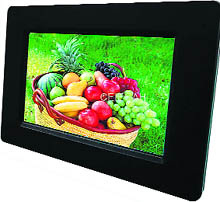While sending photos to friends online, get sharp
BITS ABOUT BYTES
Roopinder Singh
The very essence of taking a picture involves sharing it with others. After all, what are photographs other than memories immortalised. Even as we compose a picture on our viewfinder, or, more often, on the LCD screen of our camera or phone, we are already thinking of people we would love to share the moment with.
 But before we share the picture, we would like to make sure that we put our best foot forward. Since photography, as we saw in the last article (click here), is now largely digital, we often download the photographs we have taken from the camera to a personal computer.
But before we share the picture, we would like to make sure that we put our best foot forward. Since photography, as we saw in the last article (click here), is now largely digital, we often download the photographs we have taken from the camera to a personal computer.
The bigger screen of the PC helps us to view the pictures and it is not surprising that we can then find flaws. Often, the picture, especially if it has been taken with a cellphone or one of those smart, cute flat little cameras that you can slip into your purse or pocket, suddenly doesn’t seem as sharp as it did on the dinky little screen of the device.
The most common reason for that is not technical, but simply physical – camera shake. Your hand shakes as you take a picture and the image becomes blurred. While they look good, these cameras do not sit well in the hand, since they are not ergonomic.
When I had to buy a camera for Jansher, our son, I bought something that was not absolutely flat, and sat well in the hand; an Olympus SP-600UZ had a body with a curved end and sat well in the house. It has a 12 megapixel sensor and has a 15X zoom. Really good specs for a camera that a 14-year-old is going to use!
Like this camera, most mid-range cameras have image stability facility that counters a camera shake. It is fairly effective, but still, the best thing to do is to keep yourself steady, and even control your breathing for a few seconds while you press the shutter. In fact, I often find that childhood hunting skills come is very useful during photography, but that’s another story.
In the days of chemical photography it was practically impossible to fix a camera shake. When things get into the digital arena, like through scanning or directly uploaded from a camera, there are some software solutions, primarily the unsharp mask filter, which is actually a sharpening filter that emphasises the edges in the image, or the differences between adjacent light and dark sample points in an image. In expert hands, it is a tremendous tool, though a bit difficult to master. It is widely available in most image processing software.
 Focus Magic, a photoshop a plug-in for Mac, and a stand-alone software for Windows, has quite a reputation for improving shaky pictures. Other plug-ins include Image Skill’s Magic Sharpener and a freeware utility called Unshake.
Focus Magic, a photoshop a plug-in for Mac, and a stand-alone software for Windows, has quite a reputation for improving shaky pictures. Other plug-ins include Image Skill’s Magic Sharpener and a freeware utility called Unshake.
The Rolls Royce of image processing tools, Photoshop, is well, like the car, expensive, and it takes a while to master. I have been using it since it was first released for Apple computers in 1990 and I love its capabilities. It has many features and the new Creative Suites from Adobe offer much more than you can ever imagine, or use.
However, much of my basic stuff like cataloguing and even some touching up is done using a free software called Picasa, which I mentioned in my last column. It is easily downloadable, simple, uses less computing resources, and is great at cataloguing. I upload my pictures from my computer and see them Picasa. I even do some basic colour balance and retouching.
To share pictures online, I often use Flickr an image and video hosting website, owned by Yahoo since 2005. When I got involved a lot in the Vivek High School Soccer League as a parent photographer, I would take the pictures with my camera, a Nikon D-200 for those who want to know, and post the pictures on Flickr so that our son and his friends could check them out. Many bloggers also use Flickr; thought I use Picasa’s online version, Picasa Web Albums, to upload the pictures that I use in my blog, but it is a matter of personal preference, more than anything else.
Sometimes, we want to send photographs by e-mail. Most of the time camera generates really big files, which measure in MBs. Such files are of very good quality, but they take a long time to download, and are not convenient to see on a computer screen.
Most image processing programmes, including Picasa, allow you to prepare your pictures for the Web. By doing so, they decrease the quality and the file size, optimising it for sharing online and for viewing on a computer screen. Please remember that in case you want to print the pictures, you have to send the best resolution possible because the print shops need that resolution.
What happens to people who want the pictures for offline viewing? Well, as you walk into Mahijit Sodhi’s house, you notice that while the ambience is traditional, in various nooks and corners there are silent displays of pictures, changing every 30 seconds or so. These are digital picture frames, in various sizes.
Digital frames can be as small as 1.5-inch keychain displays and the biggest ones are 32-inch wall-mounted ones. However, most frames are in the 5″ to 15″ range. Most digital photo frames have Liquid Crystal Display (LCD) screens, and operate at a resolution of 720 x 480 pixels for a 7″ frame, and 1600 x 1200 pixels for those 15 inches and larger. They accept USB drives, memory sticks, or memory cards and thus you can keep adding your latest collections for display.
Many people want to hold a picture in their hands and for them, all you have to do is to upload your picture at the highest possible resolution and take it to your nearest photo processing shop to have it printed.
When you enlarge a picture too much, you will notice pixilation, or graininess in the print. The number of megapixels of the camera and the size of the CCD, coupled with the quality of the lens, all work together to give you better quality. Thus my Nikon D-200 gives better quality of pictures even though it is 10 megapixels as opposed to Jansher’s Olympus, which is 12 megapixels. Of course, the Nikkor 18-200mm DX VR lens helps a lot, too!
Photography is fun, but as you explore the world of pixels and computer algorithms, you learn much more and get involved in the technical aspects of picture taking, which makes it far easier to tweak your photographs, and share them with others, both electronically, as well as physically.
This article was printed in the Lifestyle section of The Tribune on May 18, 2010
